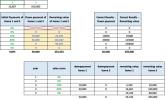Hello guys,
Imagine I have multiple types of homes (home 1, 2, 3, 4 etc), with different down payments and remaining values to be payed in "n" years. And these disbursements are controlled by a Sales Curve.
I need to find a formula to sum these different cashflows all in one go.
Please find attached an example sheet.
Any doubts, please let me know.
Imagine I have multiple types of homes (home 1, 2, 3, 4 etc), with different down payments and remaining values to be payed in "n" years. And these disbursements are controlled by a Sales Curve.
I need to find a formula to sum these different cashflows all in one go.
Please find attached an example sheet.
Any doubts, please let me know.

